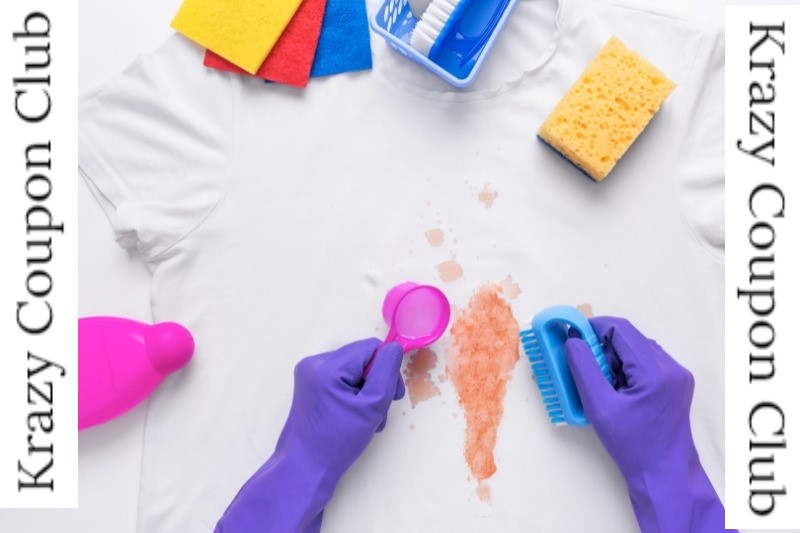How to get pink out of white clothes? White clothes are a timeless fashion choice, exuding elegance and purity. However, one common nightmare that white garment owners often face is the appearance of pink stains. These unsightly blemishes can result from various sources, such as accidentally mixing red or pink garments with whites in the laundry or even exposure to chemicals. But fear not; this article will guide you through the process of removing pink stains from your beloved white clothes, keeping them fresh and pristine.
Understanding the Stain
Pink stains can occur due to the bleeding of dyes from colored clothes onto white ones. Understanding the cause is essential for effectively addressing the issue.
What Causes Pink Stains on White Clothes?
How to get pink out of white clothes? Pink stains on white garments often occur when colorful clothing dyes transfer to your whites during the washing process. This frequently happens as a consequence of a washing mix-up, but it can also happen as a result of the inferior dyes used in the colored clothing.
Types of Stains
Let’s classify the many pink stains you might come across, such as recent stains, old stains, and persistent stains that have been through the wash, before we move on to the treatments.
Fresh Stains
Fresh pink stains are those you’ve recently noticed. The sooner you act, the easier they are to remove. These stains haven’t had the chance to set in yet.
Old Stains
Old pink stains are more challenging to remove. They might have been through several wash cycles, making the dye more stubbornly embedded in the fabric.
Stubborn Stains
Stubborn stains are the toughest to tackle. These may be old, or they might have been heat-set, making them extremely resistant to removal.
Immediate Action: Quick Tips
When you notice a pink stain on your white clothes, quick action is crucial to prevent the stain from setting. Here are some quick tips to help you deal with pink stains effectively.
Blot the Stain
Gently blot the stain with a clean cloth or paper towel to absorb excess color. Do not rub, as it can make the stain worse. Blotting helps to lift the excess dye off the fabric’s surface. Use a white cloth to prevent any color transfer.
Rinse with Cold Water
Rinse the stained area with cold water immediately to flush out the dye. Avoid using hot water, as it can set the stain further. Cold water helps dilute and remove the dye before it bonds with the fabric. Hold the fabric under the cold running water, directing it from the back of the stain to the front. This helps to push the dye out of the fabric.
Apply Salt
Salt should be applied to the stain after blotting and rinsing to aid in dye absorption. Before repeating the rinse, let it sit for a while. The extra color can be absorbed by salt, making removal simpler. Rinse the item thoroughly once the salt has absorbed all the pigment it can.
Soak in Milk
If the pink stain is particularly stubborn, consider soaking the affected area in cold milk. Milk contains enzymes that can help break down the dye. Soak the garment for several hours, then launder it as usual.
Use Liquid Laundry Detergent
Directly on the stain, use a tiny amount of liquid laundry detergent. To help the detergent penetrate the fabric, gently massage it together. After letting it sit for a short while, wash the item in cold water.
Check for Stain Residue
How to get pink out of white clothes? After applying any of the above methods, check the stained area. If any residue remains, avoid drying the garment, as heat can set the stain. Reapply the chosen method until the stain is completely gone.
Remember that patience and persistence are key when dealing with pink stains on white clothes. It may take multiple attempts to fully remove the stain, especially for older or more stubborn stains.
With these quick tips, you can take immediate action when you discover a pink stain on your white clothes, increasing your chances of successful stain removal.
Homemade Remedies
For those who prefer natural and DIY solutions, there are several effective remedies you can try.
Baking Soda and Vinegar
Create a paste using baking soda and vinegar. Apply it to the stain and gently rub the fabric. Baking soda acts as an abrasive while vinegar helps break down the dye. Rinse with cold water after treatment.
Lemon Juice and Sunlight
Lemon juice can act as a natural bleaching agent. Apply it to the stain and let the garment dry in direct sunlight. The combination of lemon juice and sunlight can help fade the stain.
Hydrogen Peroxide
Dilute hydrogen peroxide with water and apply it to the stain. Hydrogen peroxide is a mild bleach that can help remove dye stains. Rinse thoroughly afterward.
Store-Bought Stain Removers
Sometimes, commercial stain removers are the most effective way to tackle pink stains on white clothes.
Pre-treating Stains
Consider using a quality stain remover. Follow the instructions on the product label for pre-treating stains. Pre-treating involves applying the product directly to the stain before washing.
Choosing the Right Product
Select a stain remover designed to tackle tough stains, especially those related to color bleeding. Look for products with good reviews and a reputation for being effective on dye stains.
Laundry Hacks
Proper laundry practices can help prevent pink stains from occurring in the first place.
Adjusting Water Temperature
Wash white clothes in cold water to prevent dye bleeding. Save hot water for sturdy fabrics that can handle it. Cold water minimizes the risk of dye transfer.
Sorting Clothes Properly
Separate whites from colors to avoid accidents. Wash white clothes together to minimize color contamination. Sorting your laundry correctly is an essential preventive step.
Using Color Catcher Sheets
These handy sheets absorb stray dyes in the wash, preventing them from settling on your white clothes. Color catcher sheets are readily available in most stores and can be used with each load to protect your whites.
Preventing Pink Stains
Color Separation
Make sure there are no colored clothes in your pile of white clothes before laundry day. It’s a straightforward but efficient method for avoiding pink stains altogether.
Checking Clothes Before Washing
Inspect clothes for stains before tossing them in the washing machine to prevent future surprises. A quick check can save you from dealing with unwanted stains.
Alternative Solutions
Seeking Professional Help
If the stain is too stubborn, consider professional dry cleaning services. They have access to specialized stain removal techniques and chemicals that may be more effective in extreme cases.
Dyeing Your Clothes
If the stain remains despite your best efforts, consider dyeing your white garment a new color to camouflage the stain creatively. You can transform your white clothes into a fresh, trendy color.
Conclusion – How to Get Pink Out of White Clothes
Pink stains on white clothes can be frustrating, but with the right knowledge and quick action, you can restore your garments to their former glory. Whether you opt for homemade remedies, store-bought stain removers, or preventative measures, there’s a solution for every situation. Keep your whites pristine, and confidently flaunt your fashionable white attire.
Frequently Asked Questions
Q: Can I use bleach to remove pink stains from white clothes?
A: While bleach can be effective, it’s essential to be cautious, as it can weaken fabric fibers and cause yellowing. Consider alternatives first.
Q: How do I prevent dye bleeding when washing clothes?
A: Separate your clothes by color and use color catcher sheets to minimize the risk of dye bleeding.
Q: What should I do if the pink stain is old or stubborn?
A: Try a combination of homemade remedies and stain removers. If the stain persists, consult a professional cleaner.
Q: Is it possible to restore the original white color of a stained garment?
A: It is indeed feasible. To restore the white color of your garment, use natural remedies or store-bought stain removers while using the right washing procedures.
Q: Can I avoid pink stains by washing white clothes separately?
A: Pink stains can be avoided by washing white garments separately, especially if you have had this problem in the past. It’s a straightforward yet powerful preventative approach.
Investigate an Augmented Selection of Articles: How to Get Lint Balls off Clothes



